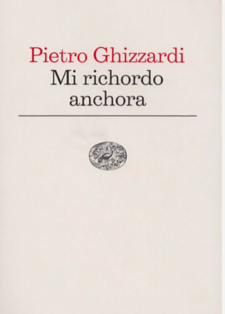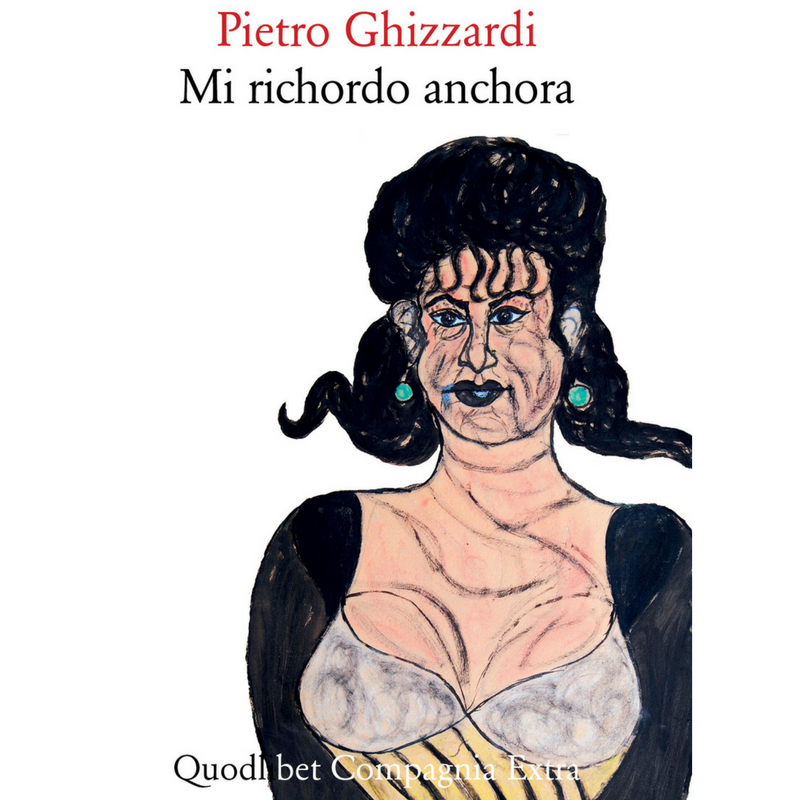Mi richordo anchora
(“I still remember”)
✦ 1st Edition
edited by Giovanni Negri and Gustavo Marchesi, with a note by Cesare Zavattini, Einaudi, Turin 1976
Winner of the Viareggio Literary Award: debut novel in the category of fiction 1977
✦ 2nd Edition
edited by Giovanni Negri and Gustavo Marchesi , with a note by Cesare Zavattini and a foreword by Alfredo Gianolio, Quodlibet, Macerata 2016
“at my funeral I want to be carried to the graveyard with no flags of any colour I don’t do it because I refuse the flag I do it because I don’t want any luxury behind me I want to be carried on a cart dragged by two seven-year-old oxen otherwise if they can’t find any oxen a nice horse would do, one of that breed which existed a hundred years ago fastened to its coffin like they used to do a hundred years ago with its carter aside who from time to time should make it hear some crack of the whip I want to be accompanied by an animal created by Jesus but not by a car created by a mechanic (…) and then I want to be put in an oven (…) without the cross because from my birth until today more or less I have always had a cross to bear and this is why I no longer want to see the cross (…)”
Pietro Ghizzardi, Mi richordo anchora
Mi richordo anchora is the autobiography of the primitive painter and writer from Reggio Emilia Pietro Ghizzardi, among the main exponents of the European art brut, which he wrote over a span of many years on an old book of accounts that he recycled.
This work, published by Einaudi in 1976 in the book collection Gli Struzzi, edited by Gustavo Marchesi and Giovanni Negri with notes and introduction by Cesare Zavattini, won the Viareggio Literary Award as debut novel in 1977.
At the time it caused immediate interest among the Italian cultural panorama, entering the rift of the “wild” literature by non-writer writers.
The specific nature of this text is such that it makes it deeply eccentric regarding any classifying intent, as its insertion into Il piacere della letteratura (1981) by Angelo Guglielmi demonstrates, even just at first blush. He defines Ghizzardi “illiterate but writer” and in this way he places him side by side with other so called “primitive writers”, who nonetheless lacked that magmatc linguistic creativity and figurative vividness of the author in question.
The poetic corpus of Ghizzardi’s naive writing – not unplanned nor improvised though, even in its urgency – a koine of a dialect transliterated into vaguely grammatical forms, dialectized Italian and hypercorrect dialect, literally builds itself through a very material language that speaks about things, animals, men and women that are humble but faithful to themselves, to their truth, their life in the fields which is made epic, cyclical, where little insignificant and prosaic facts – at the edge of scatology – from the farming world take on the colours of èpos and heroism.
The expressive simplicity is capable of opening wide passages of meaning in the everyday life, marked by misery and by a serenity which for decades has been dissolved into a pure life of consumerism, from which an ancient wisdom radiates, ancestral, always identical to itself and deeply sincerely moral.
In 1978 a documentary was dedicated to this work. It was directed by Gian Vittorio Baldi, former assistant to Pasolini and Bresson, and it was called Mi richordo anchora. Conversazione con Pietro Ghizzardi (“I still remember. A conversation with Pietro Ghizzardi”), produced and broadcast by Rai Uno for the tv series Le memorie, gli anni (“The memories, the years”) curated by Guido Levi.
Ghizzardi’s autobiography was later put into theatrical form, in 1984, when the Compagnia del Collettivo del Teatro Due in Parma cured its adaptation for theatre with the same title, directed by Gigi Dall’Aglio and interpreted by Enzo Robutti. The play was performed in Milan, Rome and Bologna.
In the same year passages from the book were recorded on disc, with the same title and edited by the music publisher Edizioni Musicali Ariston in the series Cultura Popolare. Some passages were recited by Ghizzardi himself and accompanied by his improvised musical performances on the mouth harmonica.
In 2016 on the occasion of the 40th anniversary of the book’s first edition, “Mi richordo anchora” has been reprinted by Quodlibet, within the Compagnia Extra series, directed by Jean Talon and Ermanno Cavazzoni. The brand new edition mantained the curatorial choice made by Negri e Marchesi 40 years earlier as well as the note by Zavattini, whilst a foreword by Alfredo Gianolio has been added to enrich the editorial project.
In november 2016 a new theatrical version of Ghizzardi’s book – Casa Ghizzardi. Mi richordo anchora – has been staged at illy art lab at Triennale di Milano. The play is a production by CRT Teatro dell’Arte, starring Silvio Castiglioni directed by Giovanni Guerrieri. The play has been written by Giulia Morelli and the set has been designed by Nicolò Cecchella.



